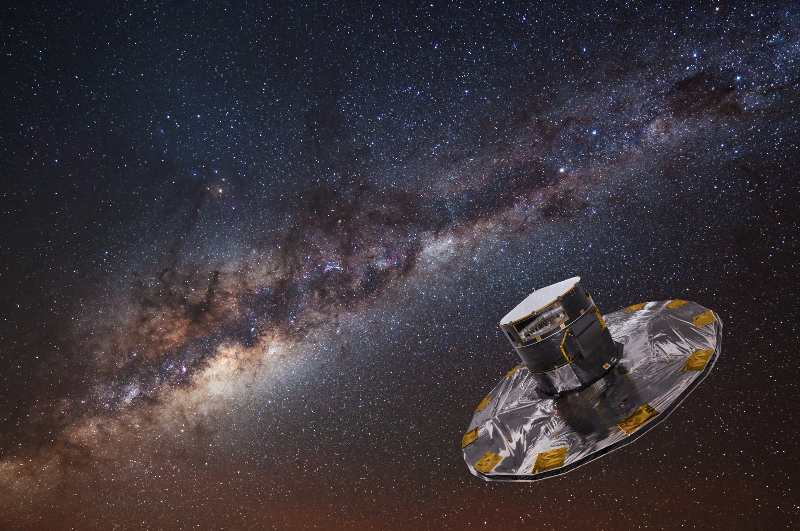
It's difficult to overestimate the importance of the Gaia mission, an incredibly intricate double space telescope launched in December 2013 and now mapping the Milky Way. We'd have to go back to the rise of the radio telescope in the 1930s to find a development more revolutionary for the exploration of our home galaxy.
Gaia DR1 will be released this Wednesday, September 14 (in most time zones) at 10:30 UTC. This first data release will not be nearly so revolutionary as future releases (see my next blog post for details) but it is an important first step that marks a rite of passage for astronomy as a whole.
What Gaia does better than any instrument ever created is measure the tiny shifts in apparent position that stars undergo as the observatory orbits the Sun and even between the two views of its precisely angled double telescopes. These shifts, called parallax, can be used to estimate a star's distance, much like surveyors use much larger parallax values to estimate the distances to buildings or mountains here on Earth.
Measuring the tiny shifts of star position to determine parallax requires Gaia to be incredibly precise - enough to measure the size of a Euro coin or North American quarter as it would appear on the surface of the Moon!
Up to this point, astronomers have largely used unreliable and sometimes frankly dodgy techniques like kinematic distance (based on rough models of gas rotating around the galactic nucleus) or photometric distance (based on guesses of the temperature of stars and the location and density of dust clouds that obscure our view of them). Both kinematic and photometric estimates require major assumptions that might turn out (and often do turn out) to be incorrect. Parallax is the gold standard of distance estimation. And distance is the key to all astronomy. We need to know how far away a star is to determine its size, its age, and its local environment.
This site, Galaxy Map, currently displays maps based on inconsistent and often incorrect distance estimates. That is about to change. A dream only seen in science fiction is about to come true: Gaia will allow detailed, extensive and accurate 3D maps of much of the Milky Way for the first time.
To see what a revolution Gaia brings, we can compare it with its pioneering predecessor, Hipparcos, launched in 1989. The Hipparcos results were accurate within one milliarcsecond for about 100 thousand stars, which was excellent using the technology available at the time.
Hipparcos created a map that was accurate to between 100-200 parsecs (330 to 660 light years). Even at the high end, this is only half way to the Orion nebula and does not even map out of much of our local solar neighbourhood, the Gould belt.
Gaia, on the other hand, has the goal of determining distance estimates for a billion stars. For the brightest 46 million stars, the mission scientists expect an accuracy of 26 microarcseconds, almost 40 times more accurate than Hipparcos. With this level of accuracy (if my calculations are correct), Gaia can determine the distance to stars in the near 3 kpc arm, which borders the galactic bar, to within 15%, and the distance to the stars in the closest Perseus and Sagittarius spiral arms to within 5%.
All of this is still in the future, however. As you'll see in my next blog post, the first data release delivers something similar to Hipparcos accuracy, albeit for 2 million stars. So it will largely offer a much more detailed map of the territory covered by the previous mission.
